After spending a day with an indigenous community that runs an eco-tourism operation on the sixth day of the trip, Day Seven was a reality check. We visited Daniel Robison's farm and learned about what he is doing to try to "save the rainforest" and what his neighbors are doing, which - in some cases - is not so good. This diary is about some of the dumbass things happening that destroy the rainforest.

"Save the Rainforest"
My trip was organized by Global Exchange and Food First. You can find out about future Food Sovereignty tours at the link.
I'd like to begin this diary with a picture (actually, two pictures):
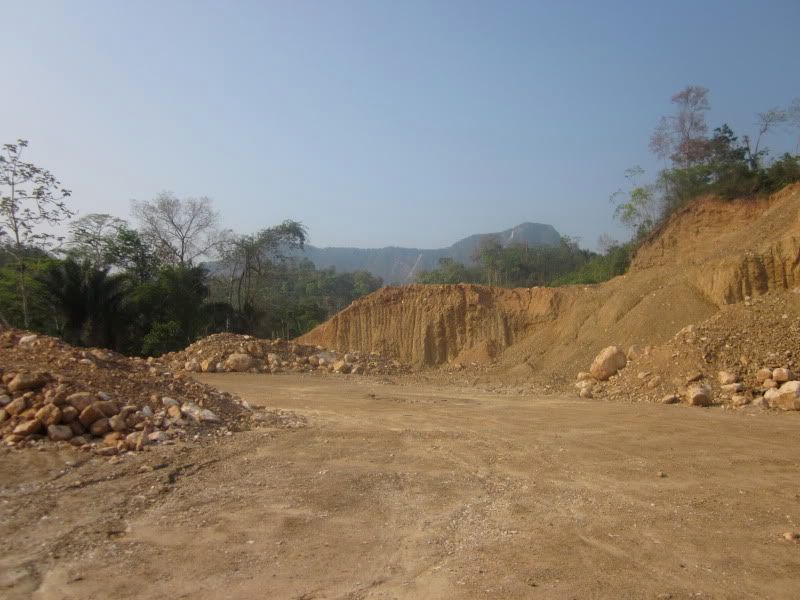 | 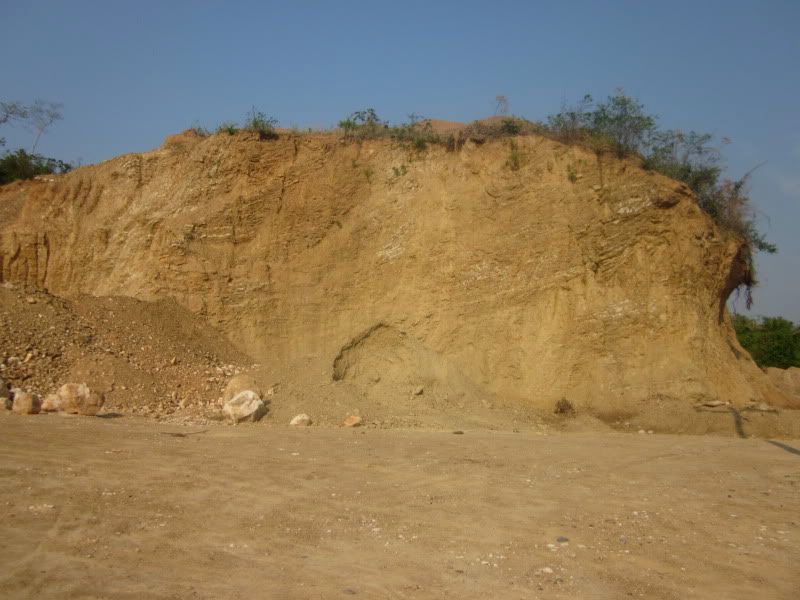 |
| Rock formation with ocean deposits. Millions of years ago, this part of the world was under water. | |
These rocks contain ocean deposits, because this part of Bolivia was once under an ocean. The land here has changed quite a bit over time and will continue to change. Over the time that the Amazon has been what we know as the Amazon, it has not been a static entity. It changes. Human activities have made the Amazon what it is, just as other human activities are destroying it. In other words: the goal is not to cordon off the entire Amazon and keep people out of it. And we should also consider that proper management by humans can actually enhance this ecosystem.
There are also some people who would see the rocks in the pictures above and then start looking around the Amazon for evidence of oil. I've heard that in some parts of the Amazon, oil companies have been quite destructive. Fortunately, for whatever it's worth, I did not personally observe this happening in the area I visited.
The next relevant picture is this one:
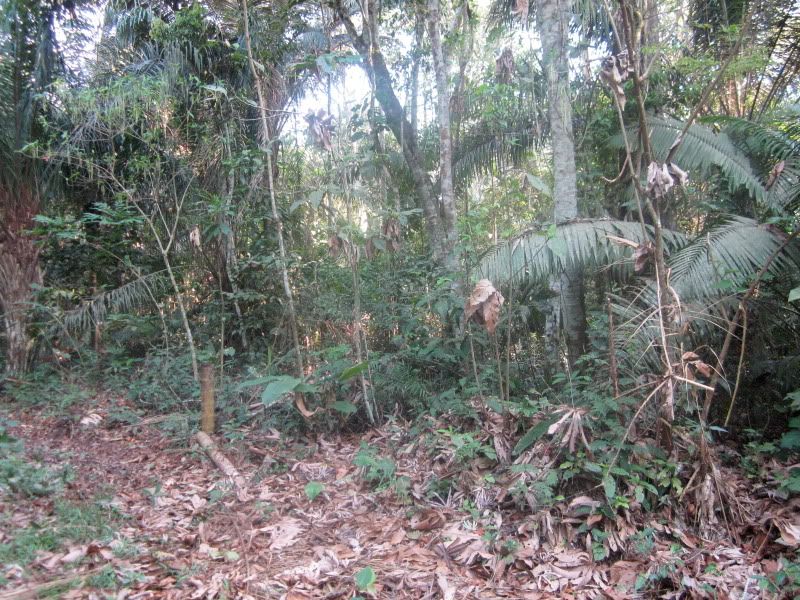
25 years ago or so, this area was slashed and burned and planted in rice. Daniel wants to leave it alone and allow it to become tall forest, and unless the law changes, that's against the law.
Daniel is planning to pick a fight with the Bolivian government at some unspecified time in the future, unless the laws change. He does not want to burn this forest. He wants to let it grow to be tall forest, and he wants to leave it that way.
So why would the government be against NOT burning the forest (or, more specifically, not USING the forest)? To find the answer, you have to look back in Bolivian history to the time of the haciendas. Landowners would own enormous swaths of land and only use a tiny fraction of it, and at the same time, the landless people of Bolivia would be going hungry. Owning forest and doing nothing with it is seen as elitist.
After the 1952 revolution, Bolivia's government did a major land reform. From that point, and until 1995, it was illegal to own land and do nothing with it. Then, in 1995, the law changed again. At that point, it was legal for people to have "private communal forest" (as Daniel put it). And since then, that law has been eroded and things are trending the other way. (Note: I'm relying on Daniel's explanation here and need to look up the actual letter of the law to confirm this.)
Let's move on to the next picture. The picture below is of a post installed by the National Land Reform Institute. It represents that all of the landholders of the adjoining properties agree that this post marks a boundary. Daniel joked that they painted the sign in yellow because it's worth more than gold.
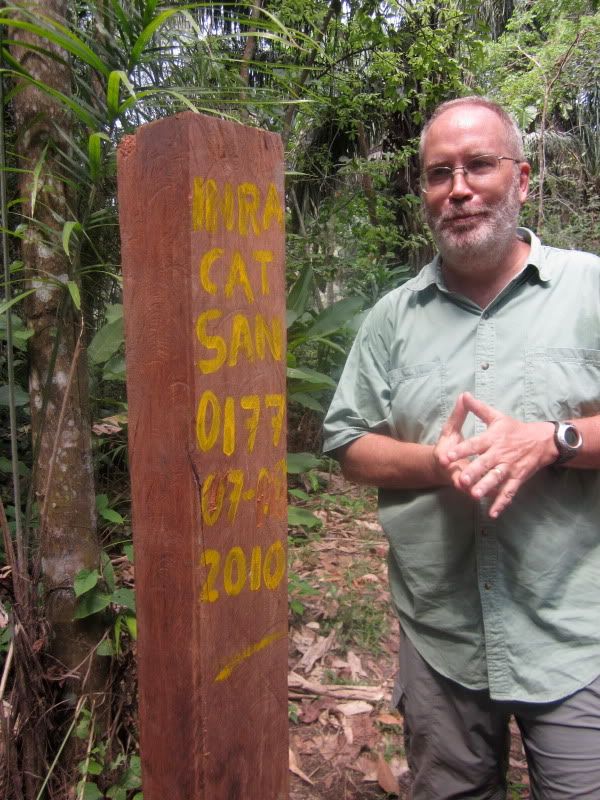
Daniel, standing next to a post that marks his property line.
What do these pictures have to do with rainforest destruction? Take a look at this:

Daniel's neighbor's property, two properties over. This guy is a speculator from Europe who burnt his forest to a crisp for no good reason.
and this:
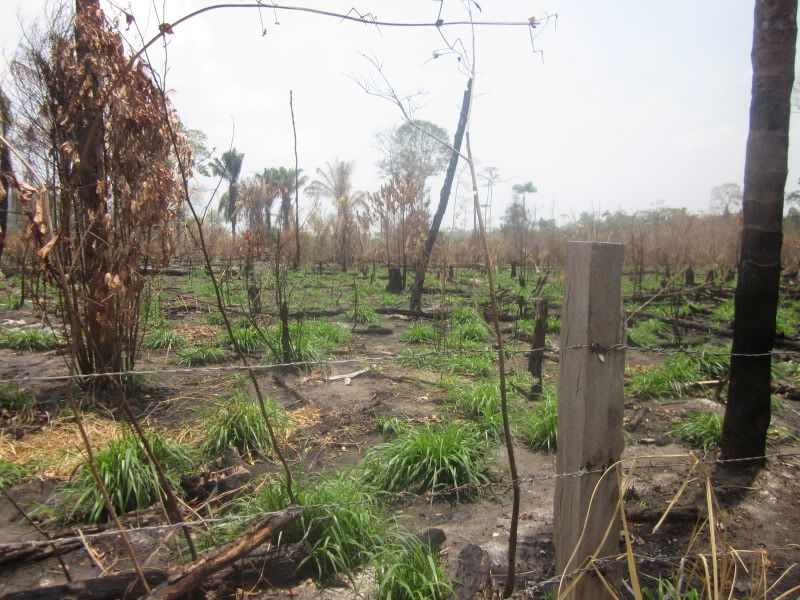
Daniel's next door neighbor, who maintains a pasture here (presumably for cattle). When the next property over went up in flames, the pasture caught on fire by accident.
and this:
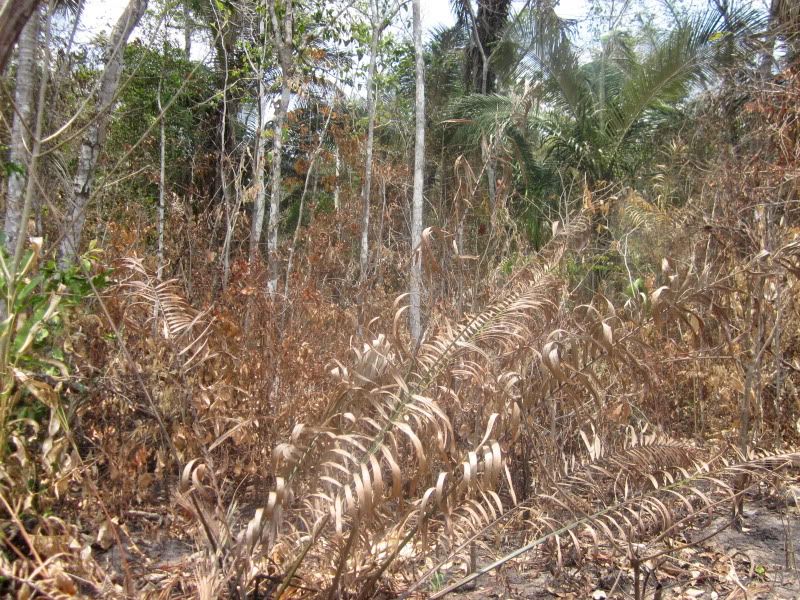
Daniel's property. This was forest, and Daniel intends to keep it as forest. It caught on fire after the pasture next door caught on fire.
When I took these pictures, we were visiting a second property that belongs to Daniel and his wife Sheila, one that I will explain below. About 10 days before our visit - BEFORE the first rains of the season (which is NOT when you are supposed to burn if you are doing slash and burn) - the National Land Reform Institute showed up in this area for the first time in a long while. Daniel's neighbor two properties over - a speculator from Europe - was eager to justify his right to his property. So first he had the National Land Reform Institute put in some markers to show where his property was, then he lit a match to his forest (to "prove" he's using it), and then he walked away.
The forest was extremely dry since it hadn't rained, and the fire spread to Daniel's next door neighbor's pasture. Then it spread to Daniel's property. Daniel and Sheila spent hours putting the fire out, and in the end, the only lost 5 hectares (about 12 acres) to the fire. The fire also spread into the Pilon Lajas Biosphere Reserve, a 400,000-hectare protected area that abuts Daniel and Sheila's property. Fortunately, after the fire spread into Pilon Lajas, it rained, and the fire went out.
So there's slash and burn agriculture, which can be practiced in an ecological way, but then there are idiots who torch their property just to justify their ownership of it. And sometimes those idiots also lose control of their fires and the fire spreads to other properties, as happened in this case.
I saw property after property burned along the road we drove out of Rurrenabaque on that day. Daniel said people get touchy when the "authorities" are around (there was road construction going on). In many cases, it looked as if the areas burned were in the early stages of succession, hinting that they had not been left fallow long enough to properly carry out slash and burn agriculture. We also passed what appeared to be a logging operation, with a yard strewn with absolutely enormous tree trunks. And we were passed by several logging trucks, including the one in the picture at the top.
In addition to speculators and accidents, there's development and - perhaps the biggest cause of deforestation - cattle ranching. In the last post, I showed you Daniel's cattle ranch. His ranch is an attempt to find an eco-friendly way to do cattle ranching in the Amazon, but it began as an experiment to show that agroforestry could be just as profitable as cattle ranching. But here's how cattle ranching is usually practiced in the Amazon:
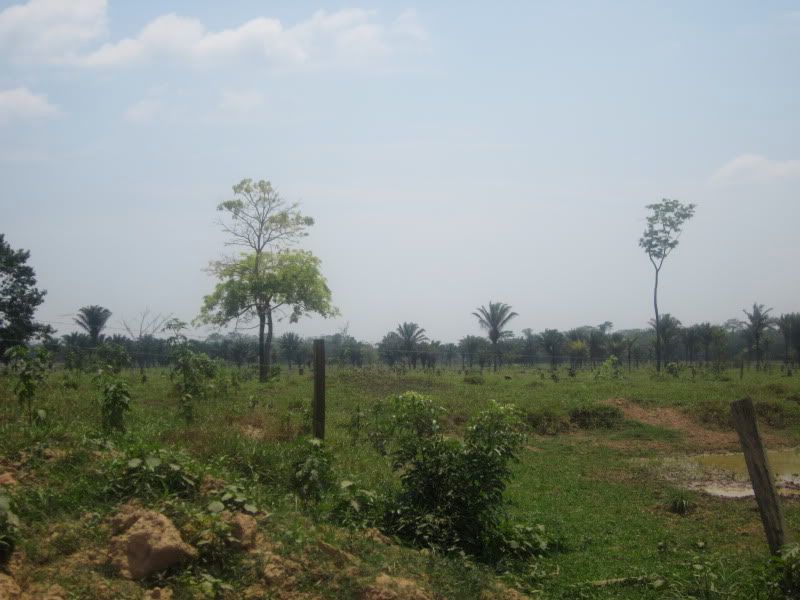
A large pasture without trees
The picture above is of a six-year-old pasture. It's a large area without trees, and it is probably maintained by burning it annually to remove any weeds. The cows are not grazed rotationally, as they are on Daniel's ranch. Daniel said that most of the 15% of the Amazon that has been deforested looks like this pasture here - or worse. "Up in Pando," he said, referring to the Amazonian department in Bolivia that is just north of La Paz, "you have to leave Brazil nut trees, which don't survive in the open, so you end up with Brazil nut corpses dotting the pastures." Daniel calls these large tree-less pastures "low carbon cattle ranching" (i.e. there is not a lot of carbon sequestered in the ecosystem).
As I said above, Daniel and Sheila began their agroforestry farm as an experiment to show that it could be just as profitable as cattle. Over the first two years, the system cost $1000/hectare to put in, the same as the cattle. Every year he spends $100/hectare on maintenance. And over 10 years, he's gotten maybe $100 (per hectare, I assume) out of it. Compare that to $200 per hectare per year in revenues that he gets from his cattle ranch.
Daniel said he has hopes for the profitability of the lumber species growing in his agroforestry system, but if all you want is lumber, why bother maintaining the forest as he does? You could just let the lumber trees grow in the forest and then cut them down when they get large enough, without spending what he has spent in maintenance.
Out of 27 fruit species, only a few have produced fruit. There's no market for fresh palm heart, and the canneries pay so little that Daniel and Sheila just eat the palm heart themselves. They can sell pineapples. Their varieties of cacao have amazing flavor but very low productivity. I believe they've had some luck with their bananas. Daniel noted they get one peach palm harvest per year. The cupuaçu tree was saw was not really producing after 10 years.
Part of the issue may be that they are using all - or nearly all - native varieties of native Amazonian fruits. They planted cacao from seed instead of grafting in more productive varieties from elsewhere, for example. So could this work if they were using other species, or other varieties of the same species? Maybe.
Much of the problem comes down to economics. Fruits and many vegetables rot. If you harvest a bunch of mangoes and take them to market, you've got a limited window of time to sell them before they are worth nothing. So you drop the price in order to get SOMETHING for them instead of nothing. That's one reason why people around here like to produce rice: it stores well.
If you've got a cow, you can keep it alive until you're ready to sell it. If the prices aren't good, then don't kill your cow. But, meat has an elastic market. If the price drops, people buy more meat. That tends to keep the price of beef up. So for a poor farmer, cattle ranching provides more economic certainty than their other alternatives. And I get the impression that most of the cattle ranching in the Amazon is done by relatively small landholders, not millionaires with enormous herds of cattle.
Then there are a few more potential (or actual) threats to the Amazon. The Bolivian government has built several dams already, and they've suggested one on the Beni River, right where we visited. These dams, when built, flood large portions of the rainforest, thus killing it. A biologist in La Paz told us they've already built three such dams elsewhere in the Bolivian Amazon (in Pando, I believe), and Daniel told us about the one proposed for the Beni River. Daniel doesn't think the dam will actually be built - at least not now.
A more pressing threat to the area of Amazon we visited is a new sugar refinery. Daniel griped that - as with the dam - this was initially the proposal of a right-wing government and now it's being carried out by the current left-wing government. Because this isn't a very good area for sugarcane, the economics of sugar production on a large scale here don't really work.
That is, in other parts of the world, it takes 3 liters of cane juice to make 1 liter of molasses. Here, we were told, it takes 6 to 10 liters of cane juice to make 1 liter of molasses. So farmers would have to produce 2-3 (or more) times as much sugarcane (and cut it and process it) just to get the same amount of sugar (and, presumably) revenues as sugar producers elsewhere who they would compete with on the world market. And a sugar refinery would require a large area of rainforest to be converted to sugar production. Yet the government is seemingly going through with it.
And, here's one last issue in the Bolivian lowlands that should be considered:
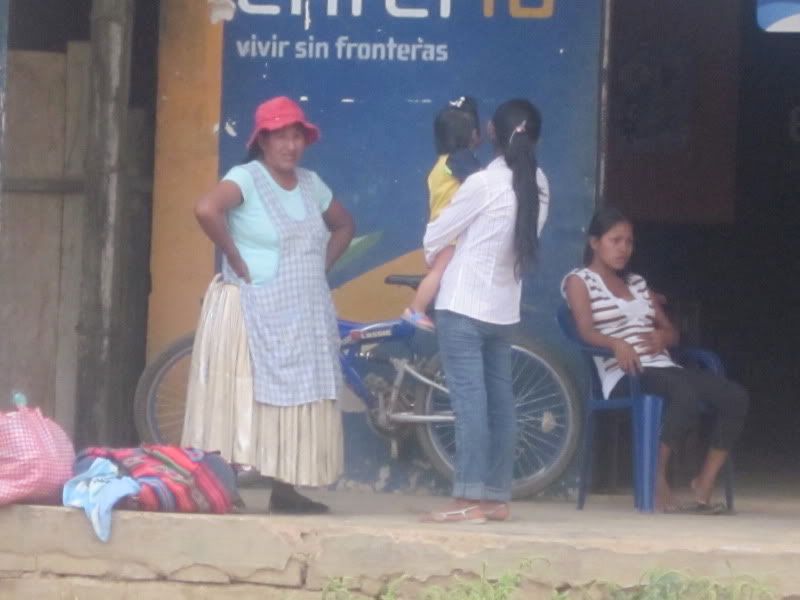
A cholita in the Amazon!
The Bolivian government has been actively resettling highlanders in the lowlands. Normally you would not see cholitas in the lowlands, but this woman has apparently moved here from the highlands. According to Daniel, the indigenous lowlanders generally do not thing this is a good idea, and the indigenous highlanders do not understand why the indigenous lowlanders aren't for it. From Daniel's point of view, Bolivia has decades of proof that any time you resettle highlanders to the lowlands, they practice monoculture. This is a complex issue but I wanted to at least mention it.
The next installment of my Bolivia diaries will cover a strange but perhaps wonderful project of Daniel's and Sheila's to preserve the rainforest.
UPDATE: Here is an excellent excerpt from the book Whispering in the Giant's Ear about how one bishop, Bishop Ramon, provides families with church land in the Amazon. Despite his good intentions, his land giveaways result in deforestation and an expansion of cattle ranching.
But it's hard to slash-and-burn your way to salvation. Bishop Ramon falls prey to the myth that if land grows trees, it must also grow crops. Quite to the contrary, the World Bank says that less than ten percent of existing rainforests grow in soils good for agriculture. Huge areas of tropical soils are composed of nitrogen-poor silica - the fossil sands of ancient oceans. In other rainforests silica dissolves out of the underlying rocks, and alumina, iron oxide, and magnesia accumulate, yielding the typical tropical "laterite" soils infused with the bright reds and yellows, and, while containing adequate nitrogen, they don't have much calcium, phosphorus, or potassium. Rainforest plants draw their nutrients not from these pitiful soils, but rather from themselves - by penetrating directly into rotting loggs. When the forest is cleared by peasants, torrential rains quickly leach away what nutrients there are, often creating gullied badlands. The bishop might as well christen the new towns Hell on Earth.
What's more, the settlers often fall prey to malaria and other tropical diseases for which their high-altitude constitutions are ill-equipped. But with nowhere to return to and their poverty often worse, they are forced to fell deeper into the Amazon as their soil erodes, thereby inadvertently acting as the shock troops clearing the jungles for cattle ranchers. More ironic still, some of the peasants the bishop so yearns to help are only pretending to be landless. They are traficantes de tierra, or land traffickers, who already have small holdings. In front of the Bishop Ramon they bow their heads and mouth the Lord's Prayer and then deforest the jungle. Once felled, it's theirs, and they hawk the land off to cattle ranchers and others.
- Whispering in the Giant's Ear by William Powers, p. 166.
No comments:
Post a Comment